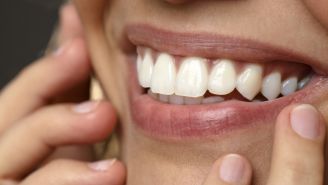Updated on September 30, 2021.
For your child’s oral and overall health, good dental care is essential at every age. Establishing a cleaning routine early makes it easier for kids to maintain strong teeth as they grow. Find out how parents and caregivers can foster oral hygiene from birth through adolescence—plus, what dental developments you can expect in the years to come.
0 to 4 months
Before your baby’s first teeth come in, gently wipe their gums with a soft cloth or rubber finger toothbrush after each feeding, for two to three seconds each time. Don’t get in the habit of putting them to sleep with a bottle of milk or juice. Avoid coating a pacifier with sugar or honey, as well, as these sugary substances can feed bacteria, causing cavities or even tooth loss later in life.
4 to 6 months
After your child’s first teeth appear, continue to wipe their gums while also cleaning teeth surfaces. From here on out, the oral health routine should occur at least twice a day, especially after eating and before sleep.
While newborns don’t need water, the American Academy of Pediatrics suggests you can introduce it to older babies when they start on solid foods, typically around 6 months of age. At this point, it’s a good idea to research the fluoridation of your tap water, since fluoride promotes good dental health. Start by inquiring with your town or city or by asking your dentist. If there’s not a sufficient amount, your dentist may prescribe a fluoride supplement.
Avoid giving your baby juice before they’re 6 months old, as it may contribute to tooth decay. Between 6 and 12 months, limit juice to 4 ounces per day, diluted 50-50 with water. Serve it only with meals.
Book your child’s first dental appointment before they turn 1 year old, or when their first tooth comes in. Ask your dentist about the recommended exam schedule; many suggest making an appointment every six months.
1 year
Needless to say, parents should continue to help with brushing at this stage. Once your baby’s mouth begins filling with teeth, graduate to a child’s soft toothbrush. Brush twice daily for about two minutes, preferably in the morning after breakfast and shortly before they turn in for the night. Until spitting is possible, use fluoride-free toothpaste or a grain-sized amount of regular fluoride toothpaste.
If your child is using a sippy cup at this point, don’t let them keep it in their mouths for extended periods, especially if it’s filled with milk or juice. If this isn’t quite possible, fill the cup with water. Between 12 and 15 months of age, your child should begin drinking from a regular cup; this can keep liquid from pooling around their developing teeth.
As before, maintain limits on juice. Between 1 and 6 years old, it’s recommended that children drink no more than 4 to 6 ounces daily, if at all.
Remember that the longer that teeth are directly exposed to sugary foods or drinks, the greater the risk of cavities—and that goes for any stage in a child’s development.
2 to 3 years
Help your child brush while teaching them how to spit out the fluoride-free toothpaste. Switch to a pea-sized amount of fluoride toothpaste when spitting becomes consistent and when recommended by a dentist. Once the edges of your child’s teeth start to touch, floss for them at least once a day. Show them how as you’re doing it.
All 20 primary (aka baby) teeth should be in by age 3; if not, consult with a dentist. At this age, it’s also smart to talk to a dentist if your child is still using a pacifier or sucking their thumb.
3 to 6 years
Adult help is still necessary at this stage. Let your child first brush independently while you supervise, then assist with any missed areas of the mouth. Continue to help with flossing, as well. Ask your dentist about dental sealants and when to take a first round of dental X-rays. The American Dental Association typically recommends X-rays when the first permanent tooth comes in, though certain situations may call for earlier imaging.
To get your child in the habit of caring for their teeth, make oral health fun. For example, try testing their skills with disclosing tablets, which use harmless, colorful dyes to expose leftover plaque.
6 to 10 years
While your child may be perfectly able to brush and floss independently, adult supervision is still important to ensure that the job gets done and that they consistently use proper technique. Keep the Tooth Fairy on speed-dial at this stage, too, as your child will likely lose most of their baby teeth.
A note about braces: Even if your child’s teeth appear to be straight, it’s not a bad idea to consult an orthodontist around age 7. This specialist can evaluate structural issues with the teeth and, if necessary, recommend braces, a retainer, or other strategies.
10+ years
Ideally, your child should have a sound understanding of home dental care by now, but it’s common to have room to improve. At age 12 or 13, check with your dentist to confirm that all permanent teeth are in place, with the exception of the wisdom teeth. Your dentist should continue to monitor for wisdom teeth through the later teenage or early adulthood years, as they may need to be pulled or surgically removed from beneath the gum line.







